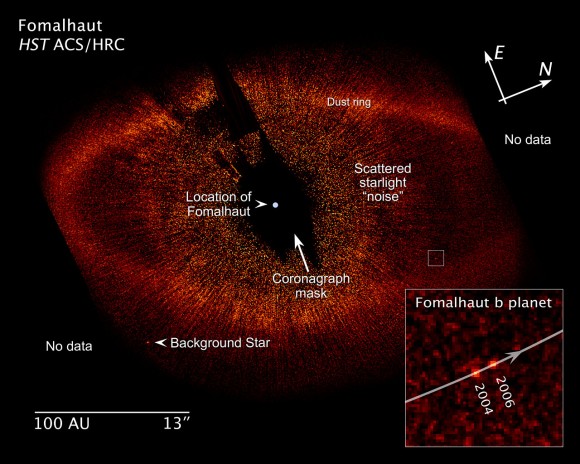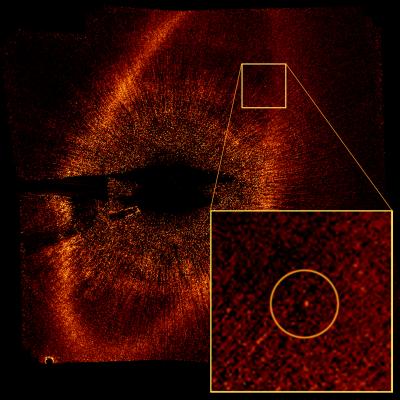[/caption]
Persistence has paid off for astronomer Paul Kalas. After eight years and taking repeated photographs with the Hubble Space Telescope of a nearby star, he finally has what he and many astronomers have been striving for: the first visible-light snapshot of a planet outside our solar system. This coincides with the announcement of the first time astronomers have taken pictures of another multi-planet solar system, using the Gemini and Keck Telescopes. Kalas has been studying the star Fomalhaut, located about 25 light years from Earth, for several years. He knew the planet was there, because its perturbations were evident in the ring of gas and dust surrounding the star. The planet is probably close to the mass of Jupiter, and it orbits Fomalhaut at a distance about four times that between Neptune and the sun. Formally known as Fomalhaut b, the planet could have a ring system about the dimension of Jupiter’s early rings, before the dust and debris coalesced into the four Galilean moons. Learn more in the video below…
The planet’s existence was suspected in 2005, when images Kalas took with the Hubble Space Telescope’s Advanced Camera for Surveys showed a sharply defined inner edge to the dust belt around Fomalhaut, in the southern constellation Piscus Austrinus. The sharp edge and off-center belt suggested to Kalas that a planet in an elliptical orbit around the star was shaping the inner edge of the belt, much like Saturn’s moons groom the edges of its rings.
“The gravity of Fomalhaut b is the key reason that the vast dust belt surrounding Fomalhaut is cleanly sculpted into a ring and offset from the star,” Kalas said. “We predicted this in 2005, and now we have the direct proof.”
Check out this video from ESA about the discovery:
“It will be hard to argue that a Jupiter-mass object orbiting an A star like Fomalhaut is anything other than a planet,” said coauthor James R. Graham, professor of astronomy at UC Berkeley. “That doesn’t mean it’s exactly what we expected when we went hunting for planets in this system.”
“Every planet has a chaotic zone, which is basically a swath of space that encloses the planet’s orbit and from which the planet ejects all particles,” said Eugene Chiang, a UC Berkeley associate professor of astronomy and of earth and planetary science, and first author of the ApJ paper. “This zone increases with the mass of the planet, so, given the size of the chaotic zone around Fomalhaut b, we can estimate that its likely mass is in the vicinity of one Jupiter mass.”

Kalas now has two photographs of the planet, taken in 2004 and 2006, which show that its movement over a 21-month period exactly fits what would be expected from a planet orbiting Fomalhaut every 872 years at a distance of 119 astronomical units, or 11 billion miles. One astronomical unit (AU) is the average distance between the Earth and the sun, or 93 million miles.
“I nearly had a heart attack at the end of May when I confirmed that Fomalhaut b orbits its parent star,” Kalas said. “It’s a profound and overwhelming experience to lay eyes on a planet never before seen.”
Sources: EurekAlert, ESA’s Space Telescope site


Congratulations, Kalas. This is the coolest thing I’ve seen all month maybe all year.
Simply amazing!
It will be nice if we can start getting more of these now that we’ve been able to get the 1st one.
Its only the beginning!
So, do they have any moons then? 🙂
Amazing work! Start of another era in planetary science!!!
Congrats to the team!!
That’s the stuff right there. Awesome!
Isn’t this discovery one of the holy grails of astronomy?
question, photographs are from 2004 and 2006, but only now being revealed, in 2008? what have they been doing the past 2 years?
Bureaucracy?
Why is this in ApJ and not Nature??
This will open a new kind of era for astronomy. It will eventually get a nobel prize fure sure. Time will tell me right or wrong.
But the impact of directly detecting an extrasolar planet rather than using indirect means such as spectral analysis of stars etc. is huge,
Put it this way. For skepticals, Now you know that for sure, No question added that there are extrasolar planet. So this closes that chapter and open a new one.
I dont know why the author publish this in ApJ. Maybe because of lack of confidence and the need to get results published. but this is by far one of the discoveries of this century putting it up there with the discovery of microwave background radiation from the big bang etc.
good stuff
Wonderful !
This picture is absolutely fantastic
@ fsm : 😀
( and since this is my first post : thanks Universe Today ! you guys are the best )
Super Duper!!! Wow!! This is huge. Mankind has never imaged another planet outside the solar system, and how long have we been on this planet?
This is as big as when William Herschel shooked the world with his discovery of a planet when no other planet had ever been discovered since the obvious ones.
In honor of Herschel, I have an idea for a name for one of the planets.
Good job!
Hey, Ed, those are awesome pics but that system was seen face on. I wonder if that can be done for all systems?
And what about the two precious star systems that were found in the same manner. For example 1RXS J160929.1-219524 and 2M1207b. Seems that these pics are not “the first” as stated. You need to read the comments on Scientific America that appeared on Daily Astronomy 11-13.
This is exciting beyond expression. When I first saw that picture, it took my breath away. The cosmos is truly awesome!
“question, photographs are from 2004 and 2006, but only now being revealed, in 2008? what have they been doing the past 2 years?”
And announced the same day the European were announcing their discovery, what a coincidence! 😉
It’s always funny how European and American teams are trying to still each other’s thunder whenever they learn an imminent discovery from the other side of the Atlantic.
Most work in acquiring data etc takes time, years for this sort of thing, its better to announce it when your proof is conclusive and undeniable.
Still though I would have loved to see or hear about this back in 2004, how do you keep this stuff to yourself. We should start socializing with high profile astronomers, get them drunk and get them tell us all about the new stuff there working on. Nancy would you be interested in this new task? … 🙂
Anyway, it is a great time to be alive guys, and to witness stuff like this
I love Fomalhaut. When I see it, it reminds me that autumn, and darker skies are near at hand. It is the only bright becon of light in the watery constellations.
This type of story would have been unthinkable in the 1960’s. Just imagine how far we have come since those days.
This is an inspiration to our hopes that humankind will someday reach the stars.
I think in the short term, astronomers would be most interested in obtaining spectra, polarization data, magnitudes (and any variations) and alternative methods for deducing these new planet’s mass, orbital period, etc. Spectra alone of these new planetary systems, while difficult to obtain, would contain a wealth of info on the physical makeup and numerous other properties of these worlds impossible to obtain with current spectroscopic line-shifting detections of planets and be a big improvement compared to spectra deduced from planetary-transiting systems. Add to that just the aesthetic value of actually seeing a planet orbiting another star…what a way to stir up childrens (and adults) imaginations. These new direct observations were certainly predicted to occur well within our lifetimes, but where and how to look is now seriously being addressed.
and to think people wanted to take hubble out of service couple of years ago!
maudyfish:
They discovered the star 1RXS J160929.1-219524 on 1998 the “planet” as they called was identified in 2008.
2M1207b was identified in infrared spectrum september 2004 and it was assumed a “planet” because it had and inferred mass less than that of a brown dwarf.
Fomalhaut B was identified also identified in 2004 but it was in the visible light spectrum. So it is indeed the first of its kind in the visible spectrum.
When can we expect good spectroscopic readings from the new planets?
Brilliant photo. We are really getting close to the time when we might actually look at another earthlike planet outside our solar system. Then the real space race will begin!
I’m getting a hard on!
* * *
Yeah. . .little too much information there, Bigboy.
Anyway, while I am not quite as enthused as some of my fellow posters, I am still delighted and impressed by this discovery.
Great work by all parties!
I think I see a little blue in there. That’s right, that’s why it’s named Fomalhaut b, b stands for blue 🙂
About: “ Hubble Directly Observes a Planet Orbiting Another Star”
THIS SYSTEM CAN BE VERY OLD, AND NOT YOUNG!
Interesting news ! Heartiest greetings to the Hubble team & NASA team.
But… the news has contradictions with known theories and it was a prediction 20 years ago from the Universal Matrix Theory. Are there wrong interpretations from Hubble’s collected data? Let’s see the following:
1) It is possible that the body is not a planet, anymore. It is brighter than the expected. It can be a very old planet going to be a pulsar;
2) The excess of dust around the star can be disposable material from an old, dying star, and not about a young star;
3) Maybe the star is not so different from the sun, about long life. The sun can reach 10 billions years. We have a lot of data from the sun. We have few data from that star. Who could authorize us to say there is star living only 1, 2 billion years? Everything is suggesting the star has the same time of life like any other star. Our models are suggesting the star is about 7 billions years old.
The Universal Matrix models ( http://theuniversalmatrix.com ) suggests that old stars produces dust while its combustible is finishing, like any other fire you see at Earth. When the star become old, its planets are old also, they begin to be brighter, till becoming a pulsar. The tiny edge at the dust can be the initial formation of a new black hole, as we can see at the models.
By the way, congratulations and thanks for the good job. We work with data like that to testing our models…